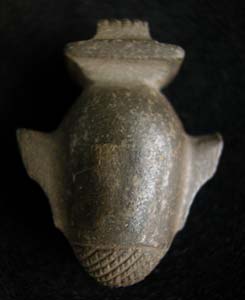Egyptian Diorite Heart Amulet, 2000 BCE - 300 BCE
Diorite
1.125 x 1.375
PF.2964
The ancient Egyptians believed that the heart was the seat of the intellect and performed the functions that we now attribute to the brain. The Egyptians believed that when a...
The ancient Egyptians believed that the heart was the seat of the intellect and performed the functions that we now attribute to the brain. The Egyptians believed that when a person died, Osiris would judge his or her soul before a tribunal of gods. The god Thoth would lead the deceased before a set of scales and weigh the heart against the feather of Ma'at, the personification of truth and order. If the deceased's heart balanced with the feather, he or she was judged to be "true of voice" and could proceed into the afterlife. If, however, the heart didn't balance, a monster, which stood beneath the scales, would devour it and the soul would be condemned to perish. Not surprisingly, the Egyptians took great care to preserve and protect the heart of the deceased. They would also provide the deceased with spells and charms, which would insure the desired verdict in the weighing of the heart. This lovely obsidian heart is rendered in the distinctively stylized form (which looks somewhat like a cross between a jar and an acorn) that the Egyptians employed in all of their representations of the heart, including the bi-consonantal sign ib.



